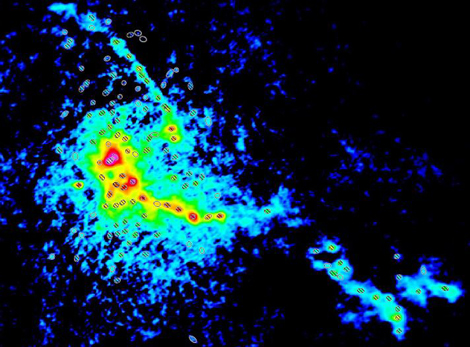French National Center for Scientific Research (CNRS) | 2018 Apr 30
An international team led by researchers at CNRS, Université Grenoble Alpes and the French Alternative Energies and Atomic Energy Commission (CEA) has challenged currently held ideas about star formation. The unprecedented resolution of the observations obtained using the Atacama Large Millimetre/Submillimetre Array (ALMA) enabled them to measure the quantity of high-mass star-forming cores in a remote, very active region of our Galaxy, and show that there is a higher proportion of them there than expected. Published in Nature Astronomy, the findings could challenge the widespread assumption that the mass distribution of a population of star-forming cores is identical to that of the stars they spawn.
- The active star-formation region W43-MM1, as observed using the world's largest millimetre interferometer, ALMA. The high number of star formation sites, known as cores and here identified by ellipses, are evidence of the intense star formation activity in this region. (© ESO/ALMA/F. Motte/T. Nony/F. Louvet/Nature Astronomy)
In space, hidden behind the dusty veils of nebulae, clouds of gas clump together and collapse, forming the structures from which stars are born: star-forming cores. These cluster together, accumulate matter and fragment, eventually giving rise to a cluster of young stars of various masses, whose distribution was described by Edwin Salpeter as an astrophysical law in 1955.
Astronomers had already noticed that the ratio of massive objects to non-massive objects was the same in clusters of star-forming cores as in clusters of newly-formed stars. This suggested that the mass distribution of stars at birth, known as the IMF (initial mass function), was simply the result of the mass distribution of the cores from which they formed, known as the CMF (core mass function). However, this conclusion resulted from the study of the molecular clouds closest to our Solar System, which are not very dense and therefore not very representative of the diversity of such clouds in the Galaxy. Is the relationship between the CMF and the IMF universal? What do we observe when we look at denser, more distant clouds? ...
The Unexpectedly Large Proportion of High-Mass Star-Forming Cores in a Galactic Mini-Starburst - F. Motte et al
- Nature Astronomy (online 30 Apr 2018) DOI: 10.1038/s41550-018-0452-x
arXiv.org > astro-ph > arXiv:1804.02392 > 06 Apr 2018

